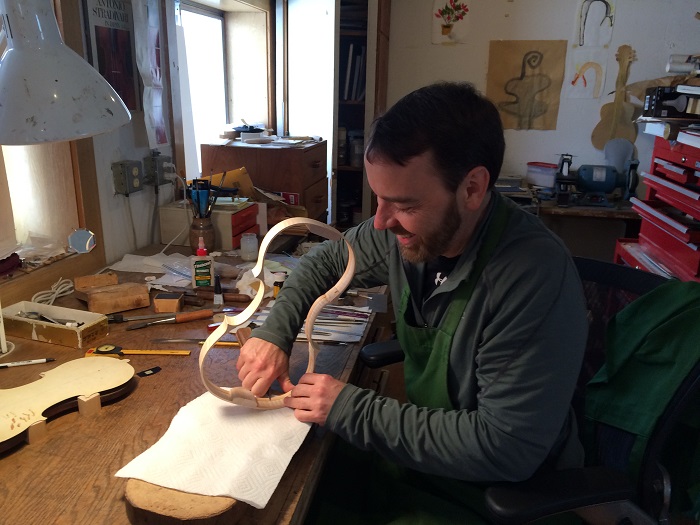“A table, a chair, a bowl of fruit, and a violin; what else does a man need to be happy.”
-Albert Einstein

I spent a recent morning in a violin maker’s shop, being given a tour by its luthier, John Young. John picks up a future violin, a pair of wooden boards, and we look at the flaming of the grain. He shows me a scattering of violin pieces, ribs, fingerboards, boxes, necks, and scrolls, all hand carved. He picks up a jar of varnish, a twist of the lid releases a whiff of turpentine, and then he shows me color samples. These objects are all scattered across his work table, waiting to be pieced together to become, not only a beautiful musical instrument, but also a work of art that combines science and history with a craftsmanship that took years to develop.
John tells me how lucky he was to be able to fulfill his childhood dream of becoming a luthier, a maker of stringed instruments. John tells me that, at age 10, and after watching a televised tour of a violin making shop on an episode of Mr. Roger’s Neighborhood, he decided that he wanted to learn how to make violins. While attending school in New York he was told that he had no options for learning this craft. It wasn’t until he traveled to Minnesota that he learned that, yes, indeed, there were schools dedicated to violin making. In Minnesota he attended the string instrument program at Red Wing Technical College, and then came to Salt Lake City, attending the Violin School of America. John Young made his first violin nearly 30 years ago and has since become an award winning luthier.

In the 16th century, the first violins, as we know them today, appeared in Northern Italy. The small Italian town of Cremona is the birthplace of the most exquisite violins ever made. The violins crafted there by Antonio Stradivari and Giuseppe Guarneri have become the standard and John supposes that 99% of modern luthiers are emulating the Cremonese masters in their own work.
“I am inspired by the violins made by Stradivari and Guarneri.” John tells me. “But, I am not making a Stradivari or Guarneri violin. I make violins that look and sound good to me.”
A violin starts with the wood. John explains how the quality and the density of the wood comprise the instrument’s strength and flexibly. At different thicknesses the wood will vibrate at specific frequencies. Each component of the violin, the body, the fingerboard, the scroll, and even the varnish, all play a role in the way the violin will ultimately sound.
John is animated as he shares his craft with me. He holds an appreciation for each step of the process, as well as the materials he works with. He exudes a passion for his profession that feels genuine and rare.
“I love making violins because I get to work with really beautiful wood, using my hands, producing something that earns me a living and provides beauty to the world and I make this object that will last way beyond my lifetime.” John Young, quoted from “Sizzle & Depth”.
“Sizzle and Depth” is a short film about John Young, produced by John’s friend, Chris Morgan, and can be viewed here.


